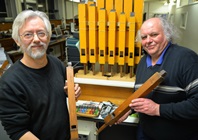Aberystwyth robotic orchestra performs at The Royal Institution

Ian Izett (left) and Dave Price, creators of the Aberystwyth robotic orchestra
19 December 2014
A ‘robotic orchestra’ built by staff at Aberystwyth University’s Department of Computer Science has been invited to take part in this year’s Royal Institution Christmas Lectures.
The orchestra will feature in the finale of this year’s Christmas Lectures which will be shown on BBC Four on New Year’s Eve at 8pm.
It currently has three instruments: a pipe organ which includes scrap components from a vacuum cleaner and various plumbing components; a child’s glockenspiel modified to be played automatically and an electronic keyboard.
The pipe organ and the glockenspiel joined a host of other robotic instruments and four human musicians but the precise details of what the performance entailed have yet to be revealed.
Dave Price, Teaching Fellow and Computer Officer at the Department of Computer Science, spent three days at the Royal Institution working on the production and coaxing the best from his robotic creation.
Dave said; “Our robotic instruments worked beautifully and didn’t miss a beat during the rehearsals. It has been a real pleasure to take part in the production of the Christmas Lectures and to work for a few days at the Royal Institution which is steeped in scientific history; this should be a real highlight of the festive season.”
The Royal Institution's Christmas Lectures were started by Michael Faraday in 1825.
In this year’s lectures ‘Sparks will fly: How to hack your home’, Prof Danielle George explores how the spark of your imagination and some twenty first century tinkering can change the world.
The lectures will be broadcast on BBC Four at 8pm on 29, 30 and 31 December.
Find out more about this year’s Royal Institution Christmas Lectures http://www.rigb.org/christmas-lectures/sparks-will-fly and on twitter @Ri_Science #xmaslectures
The human and robotic orchestra in the CHRISTMAS LECTURE ‘A new revolution’ was made possible thanks to a fantastic collaboration of robotics and engineering experts and musicians from all over the UK and even Spain.
The Music Informatics Research Group at City University London filled the role of conductor by providing the central robot orchestra control.
The Centre for Robotics and Neural Systems at Plymouth University contributed the robotic keyboards.
Aberystwyth University contributed a pipe organ which includes scrap components from a vacuum cleaner and various plumbing components, a child’s glockenspiel modified to be played automatically and an electronic keyboard.
The Synthetic Perceptive, Emotive and Cognitive Systems group at Pompeu Fabra University in Barcelona, Spain contributed the robotic iCub theremin player.
The Centre for Robotics Research at Kings College London contributed the drum bot.
The School of Electronic Engineering and Computer Science at Queen Mary University of London contributed Mortimer the drumming robot.
The National Facility for Innovative Robotic Systems at Leeds University contributed the robotic bass guitar and collaborated with National Instruments to provide an electric guitar.
The EPSRC FARSCOPE Centre for Doctoral Training at Bristol University contributed the cymbal-playing UAV.
Last, but not least, the human musicians, Robert Ames, Galya Bisengalieva, Chris Graves and Kate Hainsworth from the London Contemporary Orchestra played the viola, violin, cello and French horn.
AU54014



